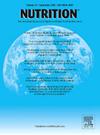接受康复疗养的老年中风患者吞咽困难改善与躯干肌肉质量增加之间的关系。
IF 3.2
3区 医学
Q2 NUTRITION & DIETETICS
引用次数: 0
摘要
目的:吞咽困难与脑卒中患者日常生活活动之间的关系已有报道,但吞咽困难改善对躯干肌肉质量增加的影响尚不明确。本研究旨在探讨老年中风患者吞咽困难改善与躯干肌肉质量增加之间的关系:这项回顾性病例对照研究招募了年龄≥65 岁的中风患者。采用 Kuchi-Kara Taberu(KT)指数对吞咽困难进行评估。根据出院时的 KT 指数将患者分为两组:吞咽困难改善组(≥57 分)和吞咽困难未改善组(结果:共有 153 名参与者,平均年龄为 79.8 ± 7.7 岁,其中 89 人(58%)被归入吞咽困难改善组。与未改善吞咽困难组相比,改善吞咽困难组的 TMI 增益更大。多元回归分析表明,吞咽困难改善(β:0.776,95% 置信区间:0.643 至 0.909,P <0.001)与 TMI 增益独立相关:结论:吞咽困难的改善与躯干肌肉质量的增加独立相关,这表明吞咽困难的改善对脑卒中患者躯干肌肉质量的增加非常重要。本文章由计算机程序翻译,如有差异,请以英文原文为准。
Association between improved dysphagia and increased trunk muscle mass in older patients with stroke undergoing convalescent rehabilitation
Objective
The association between dysphagia and activities of daily living in patients with stroke has been reported, but the effect of improved dysphagia on the increase in trunk muscle mass is not clear. The aim of this study was to investigate the relationship between improved dysphagia and increased trunk muscle mass in older patients with stroke.
Research Methods & Procedures
This retrospective, case-control study enrolled patients with stroke aged ≥65 years. Dysphagia was evaluated using the Kuchi-Kara Taberu (KT) Index. Patients were classified into two groups according to KT Index at discharge: improved dysphagia group (≥57 scores) and non-improved dysphagia group (<57 scores). The primary outcome of the study was Trunk Muscle Mass Index (TMI) gain from admission to discharge. Multiple regression analysis was performed to investigate the association between trunk muscle mass gain and improved dysphagia.
Results
There were 153 participants with a mean age of 79.8 ± 7.7 years, and 89 (58%) were classified in the improved dysphagia group. The TMI gain was greater in the improved dysphagia group compared to that in the nonimproved group. Multiple regression analysis showed that improved dysphagia (β: 0.776, 95% confidence interval: 0.643 to 0.909, P < 0.001) was independently associated with TMI gain.
Conclusion
Improved dysphagia was independently associated with trunk muscle mass gain, suggesting that improved dysphagia is important for trunk muscle mass gain in patients with stroke.
求助全文
通过发布文献求助,成功后即可免费获取论文全文。
去求助
来源期刊

Nutrition
医学-营养学
CiteScore
7.80
自引率
2.30%
发文量
300
审稿时长
60 days
期刊介绍:
Nutrition has an open access mirror journal Nutrition: X, sharing the same aims and scope, editorial team, submission system and rigorous peer review.
Founded by Michael M. Meguid in the early 1980''s, Nutrition presents advances in nutrition research and science, informs its readers on new and advancing technologies and data in clinical nutrition practice, encourages the application of outcomes research and meta-analyses to problems in patient-related nutrition; and seeks to help clarify and set the research, policy and practice agenda for nutrition science to enhance human well-being in the years ahead.
 求助内容:
求助内容: 应助结果提醒方式:
应助结果提醒方式:


